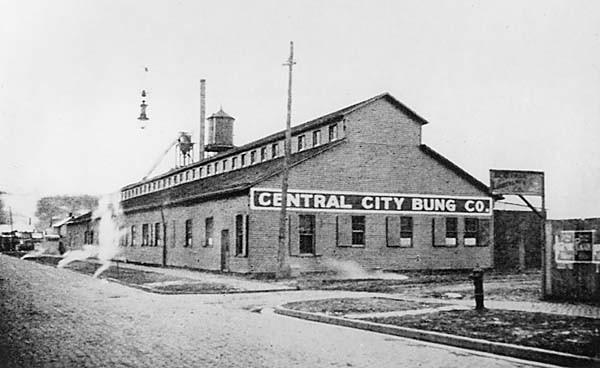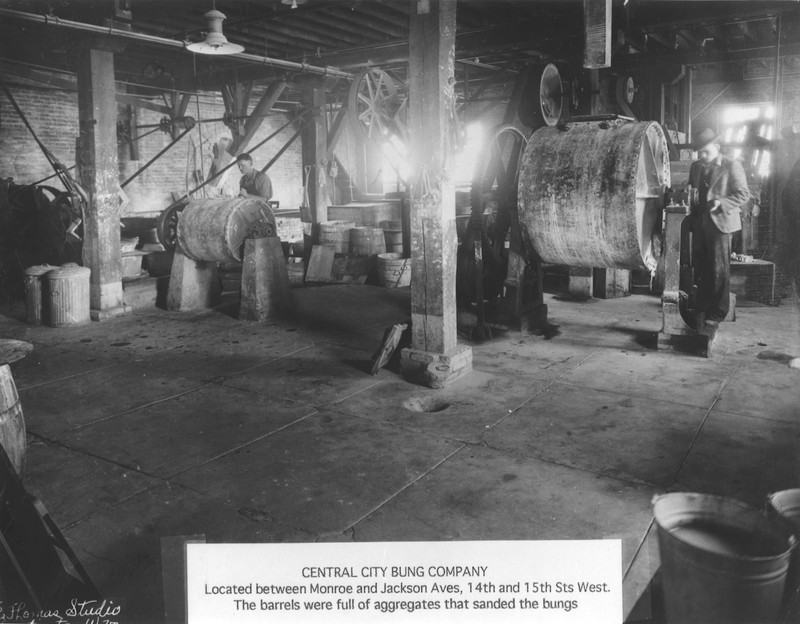Central City Bung Company (1894-1918)
Introduction
Text-to-speech Audio
Images
The only known photograph of the Central City Bung Company factory. Image courtesy of the West Huntington Public Library.

Workers inside the factory. Specialized machines were used for producing the bungs, and they reportedly were closely guarded. Image courtesy of the West Huntington Public Library.

Backstory and Context
Text-to-speech Audio
In 1888 a group of investors including John C. Hale established the West Virginia Bung Company in Elizabeth, Wirt County. A bung is a small cork-like object used to plug holes in barrels. Historically they were an essential commodity as wooden barrels for alcohol and other products were commonplace. The West Virginia Bung Company operated until 1892 when a fire destroyed the factory. Shortly afterwards, Hale was convinced to relocate the business to the new town of Central City after he was offered an entire block of land between Jackson and Monroe Avenues on which to build a replacement factory. The newly-renamed Central City Bung Company was constructed and opened in 1894.
The Central City Bung Company manufactured bungs out of poplar hardwood, which was porous and allowed the liquids inside barrels to breathe. Close proximity to multiple breweries, two railroads, and the Ohio River made Central City an ideal market for the company, which achieved rapid success. Its facilities included a woodworking building, engine room, coopers’ shed, and three warehouses; it also installed an early water sprinkler system. In 1900 the business was acquired by the United States Bung Company of Cincinnati, Ohio. The United States Bung Company had recently developed a new machine that could compress wood to squeeze out air in the pores prior to being carved into bungs. This process allowed better-quality bungs to be produced, and the new machines were soon installed in the Central City factory.
The United States Bung Company went to great lengths to keep the design of its specialized machines a secret. At the Central City factory windows were barred, security guards employed, and engineers were banned from the premises. The machines enabled the Central City Bung Company to become one of the leading producers of bungs, which were exported to places all over the world including Germany, Australia, Japan, and China. The success of the company and the niche market for bungs led to Central City being nicknamed the “Bung Capital of the World” according to some sources.
Breweries and producers of whiskey barrels were the primary clientele for bungs. Sales began declining in the 1910s as the temperance movement gained traction. The passage of prohibition in West Virginia in 1914 deprived the company of many local customers. The passage of the Eighteenth Amendment, which banned the production of alcohol nationwide, signaled the death knell for the Central City Bung Company, which closed in 1918. The United States Bung Company in Cincinnati continued to operate for a number of years; some sources state that it kept guards at the Central City location even after its machinery was removed. In 1930 the vacant Central City Bung Company facilities were sold and promptly demolished.
Sources
“A Bung Corporation.” Weekly Register. May 2, 1888.
Acts of the Legislature of West Virginia at its Nineteenth Regular Session, commencing January 9, 1889. Charleston, WV: Moses W. Donnally, Public Printer, 1889.
Casto, James E. “Lost Huntington: The Bung Factory.” Herald-Dispatch. October 19, 2015. Accessed June 16, 2019. https://www.herald-dispatch.com/special/lost_huntington/lost-huntington-the-bung-factory/article_efaa073c-deaf-5dc3-ab6b-9e0a08edf9c2.html.
McClelland, Jean. “Central City Bung Company.” Goldenseal 29, no. 4 (Fall 2003): 52-56.
Miller, Lola Roush. Central City, WV 1893-1909: A Short History. Huntington, WV: Scaggs Printing & Office Supplies, 1993.
Miller, Lola Roush. Images of America: Central City. Arcadia Publishing, 2006.
“Will Remove to Central City.” Wheeling Daily Intelligencer. July 12, 1892.
